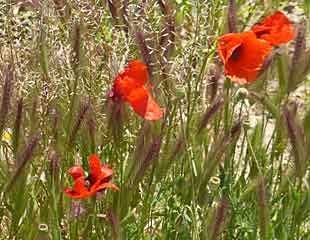Wild flowers of Crete
Posted on
 |
Wild flowers of CreteI have been to Crete several times, it’s a beautiful relaxing Greek island with lovely beaches, many tavernas and a friendly place to visit.
This time I wanted to do something different and during the winter I had been reading about the wild flowers of Crete and determine to do some, (easy,) walking and see more of the unspoiled Crete. We visited in mid-May.
Crete never disappoints, and it didn’t. The flowers and scenery were amazing, tranquil, no crowds, few cars and easy walking.
An ideal starting place to see the flowers and countryside, which is about an hour’s drive west from the busy town of Agios Nikolaos, is the Lasithi Plateau where there are wild flowers in abundance. (image above) Lasithi is a high plateau around 840 m (2,760 ft) but readily accessible in an ordinary vehicle and easy walking. In this area large parts are cultivated for food, and alongside the fields, in the fields and in any and all the spaces in between, are many wild flowers. The whole area of the Lasithi Plateau is flat and crossed with tracks and roads on which there is little traffic, other than passing farmers. Lovely walking country.
The small village of Tzermiado is a good base from where you can walk into the Lasithis plateau full of flowers, butterflies and birdsong. Tranquil and beautiful. In this area were fields of Poppy Anemone, wild gladiolus, Cretan cistus, Daucus carota, bladder campion silene vulgaris, Lavatera, and an abundance of wild grasses.
|
|
|
The plateau Kathero (illustrated below) is higher around 1,150 m (3,770 ft) above sea level, and can be accessed by one road only by an ordinary vehicle, but to explore fully a 4 wheel drive vehicle is required. The terrain is more rugged, noticeably cooler, and with many beautiful flowers such as the wild Gladious (Gladiolus italica,) Vicia tenuifolia as shown in the image. It was cool enough in May for there to be snow on the tops of the mountains and the nearby taverna had a wood burning stove on the go. This plateau is virtually uninhabitable in the winter, except for one reclusive Cretan. We were told by our guide Leonidas that in the summer the shepherds, around 140 fo them, bring their goats and live on the plateau moving down the mountain in October. The purple vicia tenuifolia is grown as animal fodder, but unfortunately the goats, bring goats, eat everything they can get to which includes the destruction of trees which they climb up and eat which stunts the tree growth. Its an ecological problem for the area.
Driving around Crete the roadsides were full of Cretan spiny broom and Nerium oleander – Oleander colourful stretches of yellow and pink. On the more rugged areas, such as walking around Mohlos the Cretan Ebony is in abundance covering parts of the hills in soft pinks.
Crete is well known for rare wildflowers and orchids. I only saw one Orchid and none of the images here or on the Pinterest page are rare flowers. In the main, I was too overawed by the lovely landscape and the natural beauty of walking, to get on my hands and knees and properly explore the range of wild flowers. Next time I will, and visit earlier perhaps April.
Lots more images
|
 |




Add a comment: